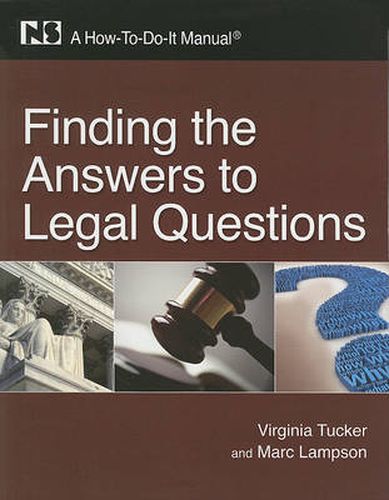Readings Newsletter
Become a Readings Member to make your shopping experience even easier.
Sign in or sign up for free!
You’re not far away from qualifying for FREE standard shipping within Australia
You’ve qualified for FREE standard shipping within Australia
The cart is loading…






This title is printed to order. This book may have been self-published. If so, we cannot guarantee the quality of the content. In the main most books will have gone through the editing process however some may not. We therefore suggest that you be aware of this before ordering this book. If in doubt check either the author or publisher’s details as we are unable to accept any returns unless they are faulty. Please contact us if you have any questions.
More people than ever are choosing to represent themselves in court and use the library as their primary, if not only, source for obtaining accurate, up-to-date legal information and legal research advice. Finding the Answers to Legal Questions: A How-To-Do-It Manual is a comprehensive guide to help public librarians confidently assist users in finding the legal information they need whether for self-representation, to be an informed consumer of legal service, or to learn the U.S. legal system, the workings of the courts, and common questions likely to arise. Authors Virginia Tucker and Marc Lampson provide a clearly organized, easy-to-use resource packed with guidance to help librarians answer questions that span the gamut of the law. There is an overview of fundamental legal information, including the basic structure of the U.S. legal system and primary law, and how-to instructions for finding primary law in print sources, free websites, and pay-for-view databases. The authors share tips for conducting a legal reference interview and describe common legal questions across a number of different areas, including lawsuits, family law, landlord-tenant disputes, wills and estate planning, debt, bankruptcy, employment, and criminal law. The authors also explain how to build a basic legal reference collection, including a how-to guide for creating a basic website of legal links and for building a small, low-cost collection of print resources. Finding the Answers to Legal Questions: A How-To-Do-It Manual is an ideal book for practicing librarians looking to better serve users’ legal needs, as well as for LIS faculty and students preparing for careers as public librarians.
$9.00 standard shipping within Australia
FREE standard shipping within Australia for orders over $100.00
Express & International shipping calculated at checkout
This title is printed to order. This book may have been self-published. If so, we cannot guarantee the quality of the content. In the main most books will have gone through the editing process however some may not. We therefore suggest that you be aware of this before ordering this book. If in doubt check either the author or publisher’s details as we are unable to accept any returns unless they are faulty. Please contact us if you have any questions.
More people than ever are choosing to represent themselves in court and use the library as their primary, if not only, source for obtaining accurate, up-to-date legal information and legal research advice. Finding the Answers to Legal Questions: A How-To-Do-It Manual is a comprehensive guide to help public librarians confidently assist users in finding the legal information they need whether for self-representation, to be an informed consumer of legal service, or to learn the U.S. legal system, the workings of the courts, and common questions likely to arise. Authors Virginia Tucker and Marc Lampson provide a clearly organized, easy-to-use resource packed with guidance to help librarians answer questions that span the gamut of the law. There is an overview of fundamental legal information, including the basic structure of the U.S. legal system and primary law, and how-to instructions for finding primary law in print sources, free websites, and pay-for-view databases. The authors share tips for conducting a legal reference interview and describe common legal questions across a number of different areas, including lawsuits, family law, landlord-tenant disputes, wills and estate planning, debt, bankruptcy, employment, and criminal law. The authors also explain how to build a basic legal reference collection, including a how-to guide for creating a basic website of legal links and for building a small, low-cost collection of print resources. Finding the Answers to Legal Questions: A How-To-Do-It Manual is an ideal book for practicing librarians looking to better serve users’ legal needs, as well as for LIS faculty and students preparing for careers as public librarians.